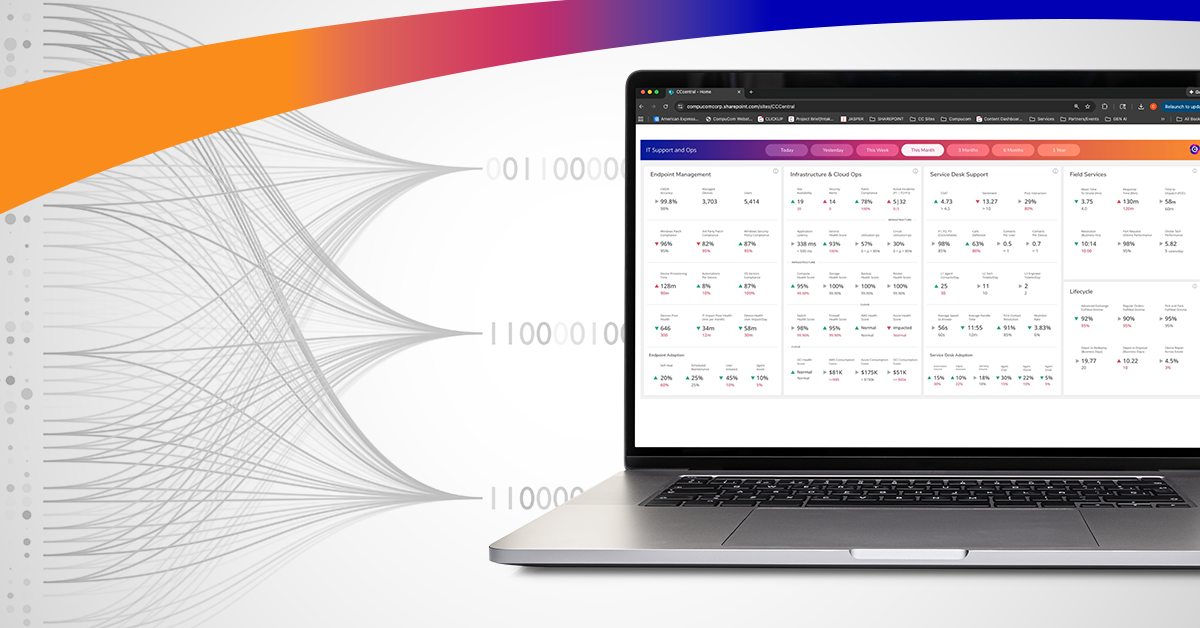- Managed Services and IT Support
- Experience Management


Marketing Compucom
Given the large shift in how employees work and where employees are working, it is clear that the employee experience has been forever altered. This means, the methods organizations use to measure employee experience need to be updated.
Learn more about the 5 Employee Experience Factors:
- Employee Well-Being
- Employee Satisfaction
- Employee Experience in the Physical Workplace
- Experience in Using Business Apps and Software and Hardware
- Employee Loyalty
The employee experience plays a key role in attracting and retaining top talent, so businesses should pay attention to the factors they will use to measure employee experience as well as the methodology used to measure each.
5 Employee Experience Factors and Ways to Measure Each
Recently, we worked with Omdia Research to survey enterprises about the current challenges associated with a distributed workforce.
The survey examined the impact of a distributed workforce on business priorities and employee experiences. Omdia surveyed a variety of C-Suite leaders to rank how they weighed the importance of 5 key employee experience factors.
1. Employee Well-Being
From an engagement perspective, looking at the number of employees enrolled or participating in workplace groups is one way to gauge employee well-being. As remote employees are not getting the benefit of face-to-face interactions in the office, empowering them to connect as a community, even virtually, can help to ease this challenge. Collaboration platforms, like Microsoft Teams, can empower employees to interact and communicate.
2. Employee Satisfaction
An Employee Net Promoter Score (eNPS) can help business leaders and team managers keep a pulse on the general satisfaction of employees. Another method to measure employee satisfaction is by examining employee turnover rates.
3. Employee Experience in the Physical Workplace
In February, Gallup reported that 56% of U.S. workers work remotely all or part of the time. One way to measure the employee experience is by assessing what at-home office amenities you offer and to what extent your associates are taking advantage of these offerings. Another way to improve the employee experience of the home office is through their technology. Working with your IT team can help give you an idea of what devices your employees are using, how they’re using them, and if they are working well for your employees’ needs.
4. Experience in Using Business Apps and Software and Hardware
Your employee experience around technology can be measured by your IT team. They can examine data around organizational usage and adoption of new devices, apps, and software, and they can also pull data from your IT service desk. Looking into the number of incident tickets being created, as well as the rate of each ticket being resolved, can be a great indicator of how well your employees are adjusting to their technology at home.
5. Employee Loyalty
Just like employee satisfaction can be measured by turnover rates, employee loyalty can as well. Because employee loyalty is closely tied to the other experience factors listed, the employee experience can have an impact on loyalty. How you measure well-being, satisfaction, experience with the physical workplace, and experience with technology can help give you a glimpse into reasons that could be leading to a higher turnover rate.
A More Dynamic and Agile Workplace
Omdia’s survey conclusion points to the importance for enterprises to consider engaging new technologies and services to successfully break down, command and control business silos to unleash more dynamic and agile workplaces. Now is the time to fast-track your digital workplace transformation plans and transition quickly from process-centric to employee-centric IT solutions and services.
“The Future of Work” is no longer somewhere over the horizon, it’s here now.
Fast forward–post the pandemic and Compucom foresees a hybrid working business model where, for most employees, there will be more flexibility in choosing where they work, whether in the office or at home. While the office will remain an important work environment for collaborative face-to-face interactions, remote work will deliver more flexibility for employee productivity and work-life fusion.
RecenT

The Mac Management Playbook: 8 Steps to Deployment at Scale

Full Lifecycle, Full Visibility: Maximizing the Value of Mac in the Enterprise

Mac in the Enterprise — Myth vs. Reality: Debunking the Top Barriers to Adoption

Maturity Assessments Set a Clear Path to IT Modernization

Opportunity in Uncertainty: Leveraging Data for Fearless Decision-Making

Opportunity in Uncertainty: Turning 6 Top IT Challenges into Strategic Advantages
TOPICS
The New Employee Experience
- Managed Services and IT Support
- Experience Management

Marketing Compucom
Given the large shift in how employees work and where employees are working, it is clear that the employee experience has been forever altered. This means, the methods organizations use to measure employee experience need to be updated.
Learn more about the 5 Employee Experience Factors:
- Employee Well-Being
- Employee Satisfaction
- Employee Experience in the Physical Workplace
- Experience in Using Business Apps and Software and Hardware
- Employee Loyalty
The employee experience plays a key role in attracting and retaining top talent, so businesses should pay attention to the factors they will use to measure employee experience as well as the methodology used to measure each.
5 Employee Experience Factors and Ways to Measure Each
Recently, we worked with Omdia Research to survey enterprises about the current challenges associated with a distributed workforce.
The survey examined the impact of a distributed workforce on business priorities and employee experiences. Omdia surveyed a variety of C-Suite leaders to rank how they weighed the importance of 5 key employee experience factors.
1. Employee Well-Being
From an engagement perspective, looking at the number of employees enrolled or participating in workplace groups is one way to gauge employee well-being. As remote employees are not getting the benefit of face-to-face interactions in the office, empowering them to connect as a community, even virtually, can help to ease this challenge. Collaboration platforms, like Microsoft Teams, can empower employees to interact and communicate.
2. Employee Satisfaction
An Employee Net Promoter Score (eNPS) can help business leaders and team managers keep a pulse on the general satisfaction of employees. Another method to measure employee satisfaction is by examining employee turnover rates.
3. Employee Experience in the Physical Workplace
In February, Gallup reported that 56% of U.S. workers work remotely all or part of the time. One way to measure the employee experience is by assessing what at-home office amenities you offer and to what extent your associates are taking advantage of these offerings. Another way to improve the employee experience of the home office is through their technology. Working with your IT team can help give you an idea of what devices your employees are using, how they’re using them, and if they are working well for your employees’ needs.
4. Experience in Using Business Apps and Software and Hardware
Your employee experience around technology can be measured by your IT team. They can examine data around organizational usage and adoption of new devices, apps, and software, and they can also pull data from your IT service desk. Looking into the number of incident tickets being created, as well as the rate of each ticket being resolved, can be a great indicator of how well your employees are adjusting to their technology at home.
5. Employee Loyalty
Just like employee satisfaction can be measured by turnover rates, employee loyalty can as well. Because employee loyalty is closely tied to the other experience factors listed, the employee experience can have an impact on loyalty. How you measure well-being, satisfaction, experience with the physical workplace, and experience with technology can help give you a glimpse into reasons that could be leading to a higher turnover rate.
A More Dynamic and Agile Workplace
Omdia’s survey conclusion points to the importance for enterprises to consider engaging new technologies and services to successfully break down, command and control business silos to unleash more dynamic and agile workplaces. Now is the time to fast-track your digital workplace transformation plans and transition quickly from process-centric to employee-centric IT solutions and services.
“The Future of Work” is no longer somewhere over the horizon, it’s here now.
Fast forward–post the pandemic and Compucom foresees a hybrid working business model where, for most employees, there will be more flexibility in choosing where they work, whether in the office or at home. While the office will remain an important work environment for collaborative face-to-face interactions, remote work will deliver more flexibility for employee productivity and work-life fusion.
Recent Blogs

The Mac Management Playbook: 8 Steps to Deployment at Scale

Full Lifecycle, Full Visibility: Maximizing the Value of Mac in the Enterprise

Mac in the Enterprise — Myth vs. Reality: Debunking the Top Barriers to Adoption

Maturity Assessments Set a Clear Path to IT Modernization

Opportunity in Uncertainty: Leveraging Data for Fearless Decision-Making




